Analysis of Antenna Systems in Wireless Communication Networks
VerifiedAdded on 2019/09/30
|6
|1213
|170
Report
AI Summary
This report provides an analysis of wireless communication and antenna systems, drawing on two research papers. The first paper explores electronically-switched directional antennas for low-power wireless networks, highlighting their ability to increase energy efficiency and extend communication range through the use of a dedicated network stack. The second paper examines the benefits of active transmit balanced antennas fed by a differential power amplifier, suggesting an alternative to traditional 50Ω connections in RFIC design, which reduces loss and increases output power. The report compares the findings, emphasizing the importance of antenna setup and modifications to enhance wireless network performance, speed, and efficiency. It suggests that electronically switched antennas are beneficial even in low wireless networks and that differential feeds to balanced antennas can increase power output. The report concludes by summarizing the key findings and suggesting various setups to maintain high-speed wireless connectivity.

Assignment
On
Wireless communications and networks
Submitted by
Name
Registration no
Date
On
Wireless communications and networks
Submitted by
Name
Registration no
Date
Paraphrase This Document
Need a fresh take? Get an instant paraphrase of this document with our AI Paraphraser
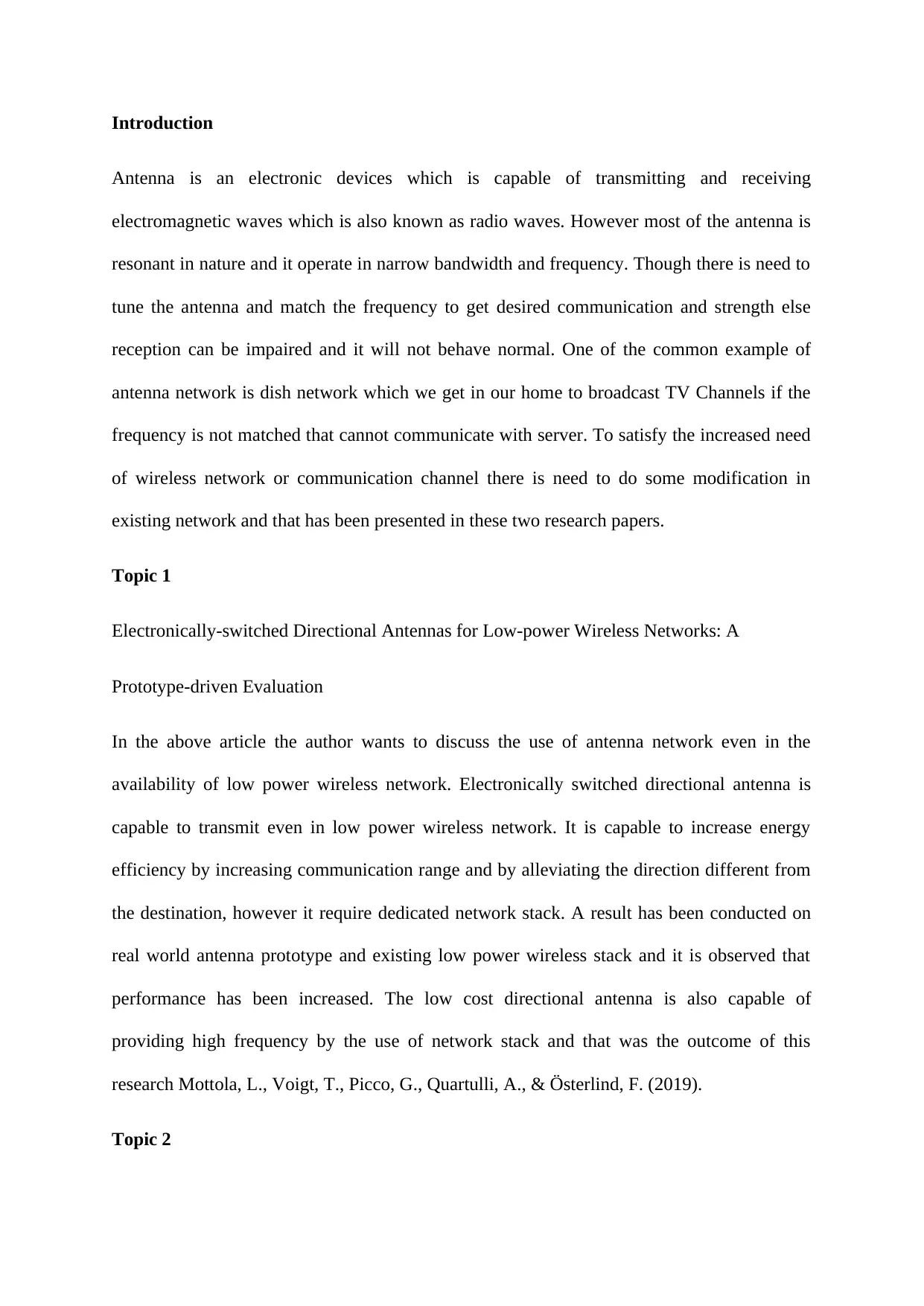
Introduction
Antenna is an electronic devices which is capable of transmitting and receiving
electromagnetic waves which is also known as radio waves. However most of the antenna is
resonant in nature and it operate in narrow bandwidth and frequency. Though there is need to
tune the antenna and match the frequency to get desired communication and strength else
reception can be impaired and it will not behave normal. One of the common example of
antenna network is dish network which we get in our home to broadcast TV Channels if the
frequency is not matched that cannot communicate with server. To satisfy the increased need
of wireless network or communication channel there is need to do some modification in
existing network and that has been presented in these two research papers.
Topic 1
Electronically-switched Directional Antennas for Low-power Wireless Networks: A
Prototype-driven Evaluation
In the above article the author wants to discuss the use of antenna network even in the
availability of low power wireless network. Electronically switched directional antenna is
capable to transmit even in low power wireless network. It is capable to increase energy
efficiency by increasing communication range and by alleviating the direction different from
the destination, however it require dedicated network stack. A result has been conducted on
real world antenna prototype and existing low power wireless stack and it is observed that
performance has been increased. The low cost directional antenna is also capable of
providing high frequency by the use of network stack and that was the outcome of this
research Mottola, L., Voigt, T., Picco, G., Quartulli, A., & Österlind, F. (2019).
Topic 2
Antenna is an electronic devices which is capable of transmitting and receiving
electromagnetic waves which is also known as radio waves. However most of the antenna is
resonant in nature and it operate in narrow bandwidth and frequency. Though there is need to
tune the antenna and match the frequency to get desired communication and strength else
reception can be impaired and it will not behave normal. One of the common example of
antenna network is dish network which we get in our home to broadcast TV Channels if the
frequency is not matched that cannot communicate with server. To satisfy the increased need
of wireless network or communication channel there is need to do some modification in
existing network and that has been presented in these two research papers.
Topic 1
Electronically-switched Directional Antennas for Low-power Wireless Networks: A
Prototype-driven Evaluation
In the above article the author wants to discuss the use of antenna network even in the
availability of low power wireless network. Electronically switched directional antenna is
capable to transmit even in low power wireless network. It is capable to increase energy
efficiency by increasing communication range and by alleviating the direction different from
the destination, however it require dedicated network stack. A result has been conducted on
real world antenna prototype and existing low power wireless stack and it is observed that
performance has been increased. The low cost directional antenna is also capable of
providing high frequency by the use of network stack and that was the outcome of this
research Mottola, L., Voigt, T., Picco, G., Quartulli, A., & Österlind, F. (2019).
Topic 2
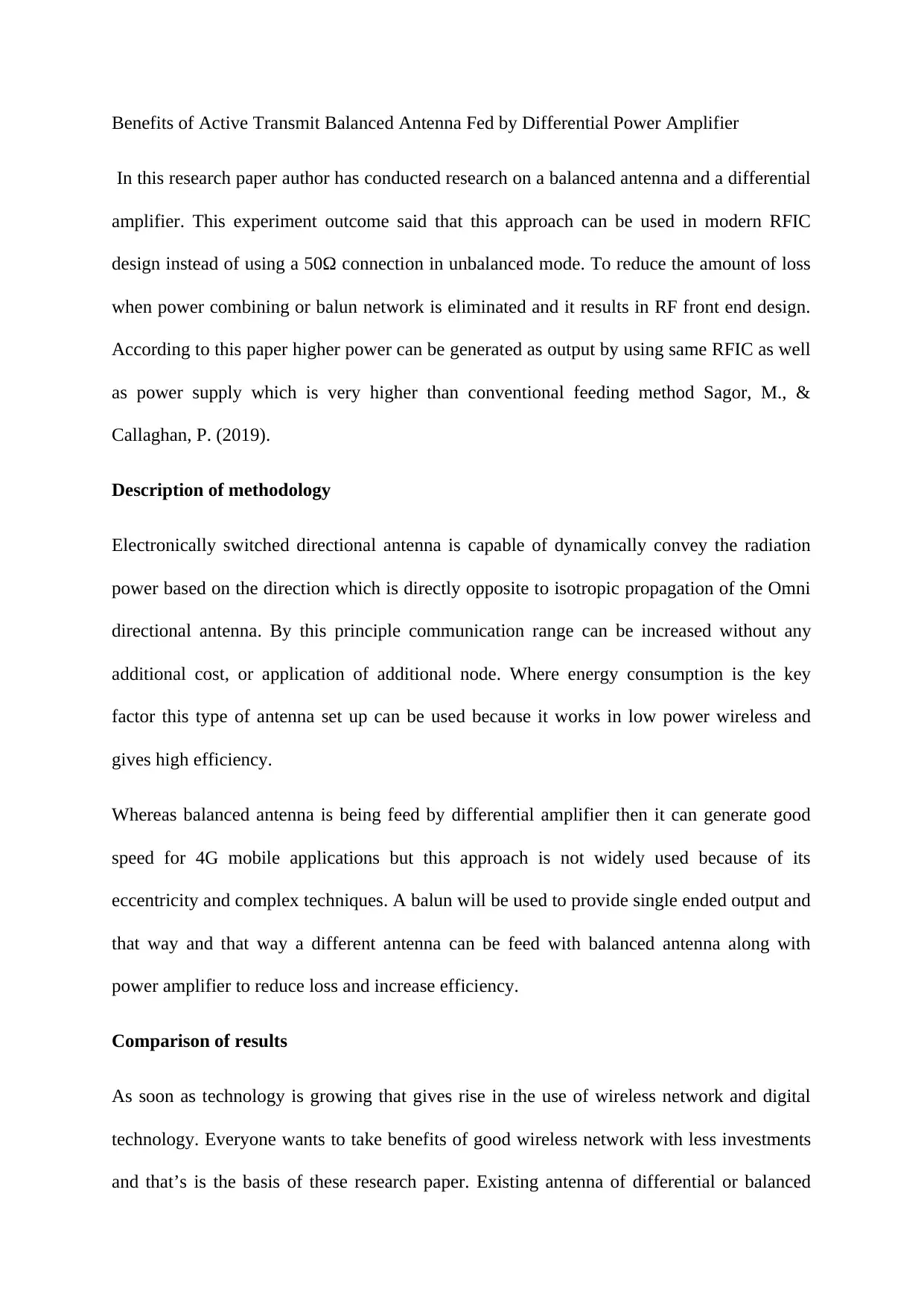
Benefits of Active Transmit Balanced Antenna Fed by Differential Power Amplifier
In this research paper author has conducted research on a balanced antenna and a differential
amplifier. This experiment outcome said that this approach can be used in modern RFIC
design instead of using a 50Ω connection in unbalanced mode. To reduce the amount of loss
when power combining or balun network is eliminated and it results in RF front end design.
According to this paper higher power can be generated as output by using same RFIC as well
as power supply which is very higher than conventional feeding method Sagor, M., &
Callaghan, P. (2019).
Description of methodology
Electronically switched directional antenna is capable of dynamically convey the radiation
power based on the direction which is directly opposite to isotropic propagation of the Omni
directional antenna. By this principle communication range can be increased without any
additional cost, or application of additional node. Where energy consumption is the key
factor this type of antenna set up can be used because it works in low power wireless and
gives high efficiency.
Whereas balanced antenna is being feed by differential amplifier then it can generate good
speed for 4G mobile applications but this approach is not widely used because of its
eccentricity and complex techniques. A balun will be used to provide single ended output and
that way and that way a different antenna can be feed with balanced antenna along with
power amplifier to reduce loss and increase efficiency.
Comparison of results
As soon as technology is growing that gives rise in the use of wireless network and digital
technology. Everyone wants to take benefits of good wireless network with less investments
and that’s is the basis of these research paper. Existing antenna of differential or balanced
In this research paper author has conducted research on a balanced antenna and a differential
amplifier. This experiment outcome said that this approach can be used in modern RFIC
design instead of using a 50Ω connection in unbalanced mode. To reduce the amount of loss
when power combining or balun network is eliminated and it results in RF front end design.
According to this paper higher power can be generated as output by using same RFIC as well
as power supply which is very higher than conventional feeding method Sagor, M., &
Callaghan, P. (2019).
Description of methodology
Electronically switched directional antenna is capable of dynamically convey the radiation
power based on the direction which is directly opposite to isotropic propagation of the Omni
directional antenna. By this principle communication range can be increased without any
additional cost, or application of additional node. Where energy consumption is the key
factor this type of antenna set up can be used because it works in low power wireless and
gives high efficiency.
Whereas balanced antenna is being feed by differential amplifier then it can generate good
speed for 4G mobile applications but this approach is not widely used because of its
eccentricity and complex techniques. A balun will be used to provide single ended output and
that way and that way a different antenna can be feed with balanced antenna along with
power amplifier to reduce loss and increase efficiency.
Comparison of results
As soon as technology is growing that gives rise in the use of wireless network and digital
technology. Everyone wants to take benefits of good wireless network with less investments
and that’s is the basis of these research paper. Existing antenna of differential or balanced
⊘ This is a preview!⊘
Do you want full access?
Subscribe today to unlock all pages.

Trusted by 1+ million students worldwide
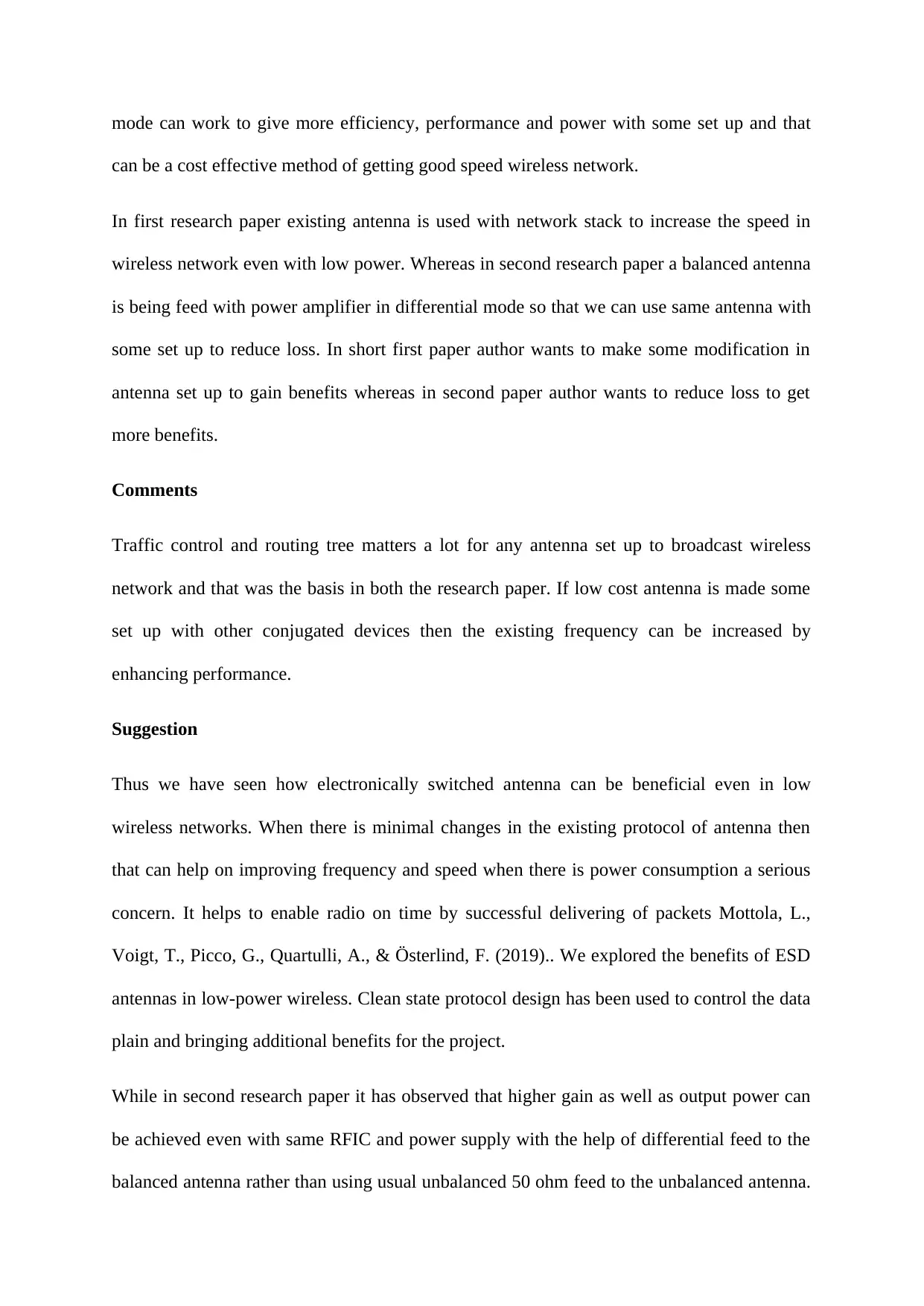
mode can work to give more efficiency, performance and power with some set up and that
can be a cost effective method of getting good speed wireless network.
In first research paper existing antenna is used with network stack to increase the speed in
wireless network even with low power. Whereas in second research paper a balanced antenna
is being feed with power amplifier in differential mode so that we can use same antenna with
some set up to reduce loss. In short first paper author wants to make some modification in
antenna set up to gain benefits whereas in second paper author wants to reduce loss to get
more benefits.
Comments
Traffic control and routing tree matters a lot for any antenna set up to broadcast wireless
network and that was the basis in both the research paper. If low cost antenna is made some
set up with other conjugated devices then the existing frequency can be increased by
enhancing performance.
Suggestion
Thus we have seen how electronically switched antenna can be beneficial even in low
wireless networks. When there is minimal changes in the existing protocol of antenna then
that can help on improving frequency and speed when there is power consumption a serious
concern. It helps to enable radio on time by successful delivering of packets Mottola, L.,
Voigt, T., Picco, G., Quartulli, A., & Österlind, F. (2019).. We explored the benefits of ESD
antennas in low-power wireless. Clean state protocol design has been used to control the data
plain and bringing additional benefits for the project.
While in second research paper it has observed that higher gain as well as output power can
be achieved even with same RFIC and power supply with the help of differential feed to the
balanced antenna rather than using usual unbalanced 50 ohm feed to the unbalanced antenna.
can be a cost effective method of getting good speed wireless network.
In first research paper existing antenna is used with network stack to increase the speed in
wireless network even with low power. Whereas in second research paper a balanced antenna
is being feed with power amplifier in differential mode so that we can use same antenna with
some set up to reduce loss. In short first paper author wants to make some modification in
antenna set up to gain benefits whereas in second paper author wants to reduce loss to get
more benefits.
Comments
Traffic control and routing tree matters a lot for any antenna set up to broadcast wireless
network and that was the basis in both the research paper. If low cost antenna is made some
set up with other conjugated devices then the existing frequency can be increased by
enhancing performance.
Suggestion
Thus we have seen how electronically switched antenna can be beneficial even in low
wireless networks. When there is minimal changes in the existing protocol of antenna then
that can help on improving frequency and speed when there is power consumption a serious
concern. It helps to enable radio on time by successful delivering of packets Mottola, L.,
Voigt, T., Picco, G., Quartulli, A., & Österlind, F. (2019).. We explored the benefits of ESD
antennas in low-power wireless. Clean state protocol design has been used to control the data
plain and bringing additional benefits for the project.
While in second research paper it has observed that higher gain as well as output power can
be achieved even with same RFIC and power supply with the help of differential feed to the
balanced antenna rather than using usual unbalanced 50 ohm feed to the unbalanced antenna.
Paraphrase This Document
Need a fresh take? Get an instant paraphrase of this document with our AI Paraphraser
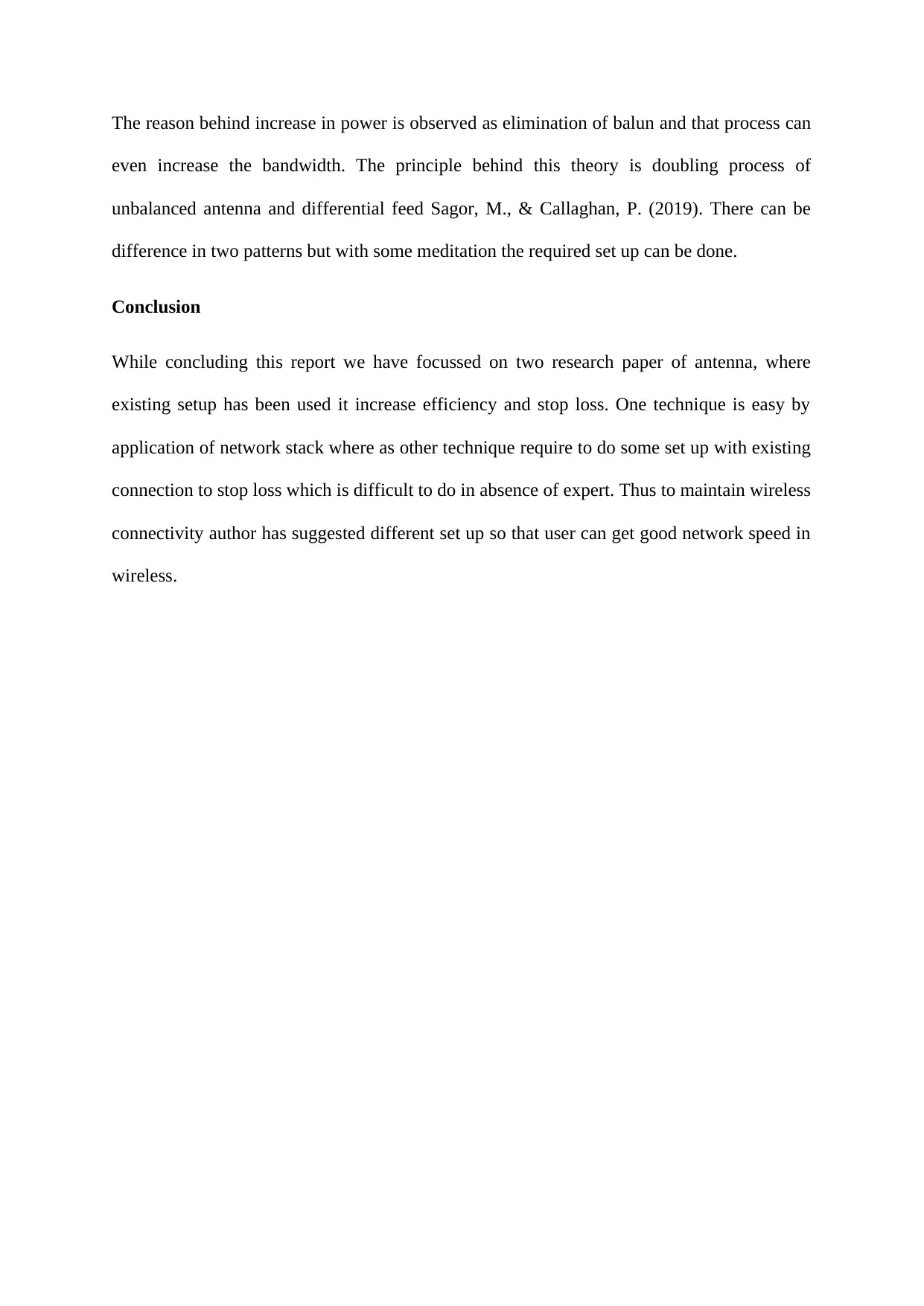
The reason behind increase in power is observed as elimination of balun and that process can
even increase the bandwidth. The principle behind this theory is doubling process of
unbalanced antenna and differential feed Sagor, M., & Callaghan, P. (2019). There can be
difference in two patterns but with some meditation the required set up can be done.
Conclusion
While concluding this report we have focussed on two research paper of antenna, where
existing setup has been used it increase efficiency and stop loss. One technique is easy by
application of network stack where as other technique require to do some set up with existing
connection to stop loss which is difficult to do in absence of expert. Thus to maintain wireless
connectivity author has suggested different set up so that user can get good network speed in
wireless.
even increase the bandwidth. The principle behind this theory is doubling process of
unbalanced antenna and differential feed Sagor, M., & Callaghan, P. (2019). There can be
difference in two patterns but with some meditation the required set up can be done.
Conclusion
While concluding this report we have focussed on two research paper of antenna, where
existing setup has been used it increase efficiency and stop loss. One technique is easy by
application of network stack where as other technique require to do some set up with existing
connection to stop loss which is difficult to do in absence of expert. Thus to maintain wireless
connectivity author has suggested different set up so that user can get good network speed in
wireless.
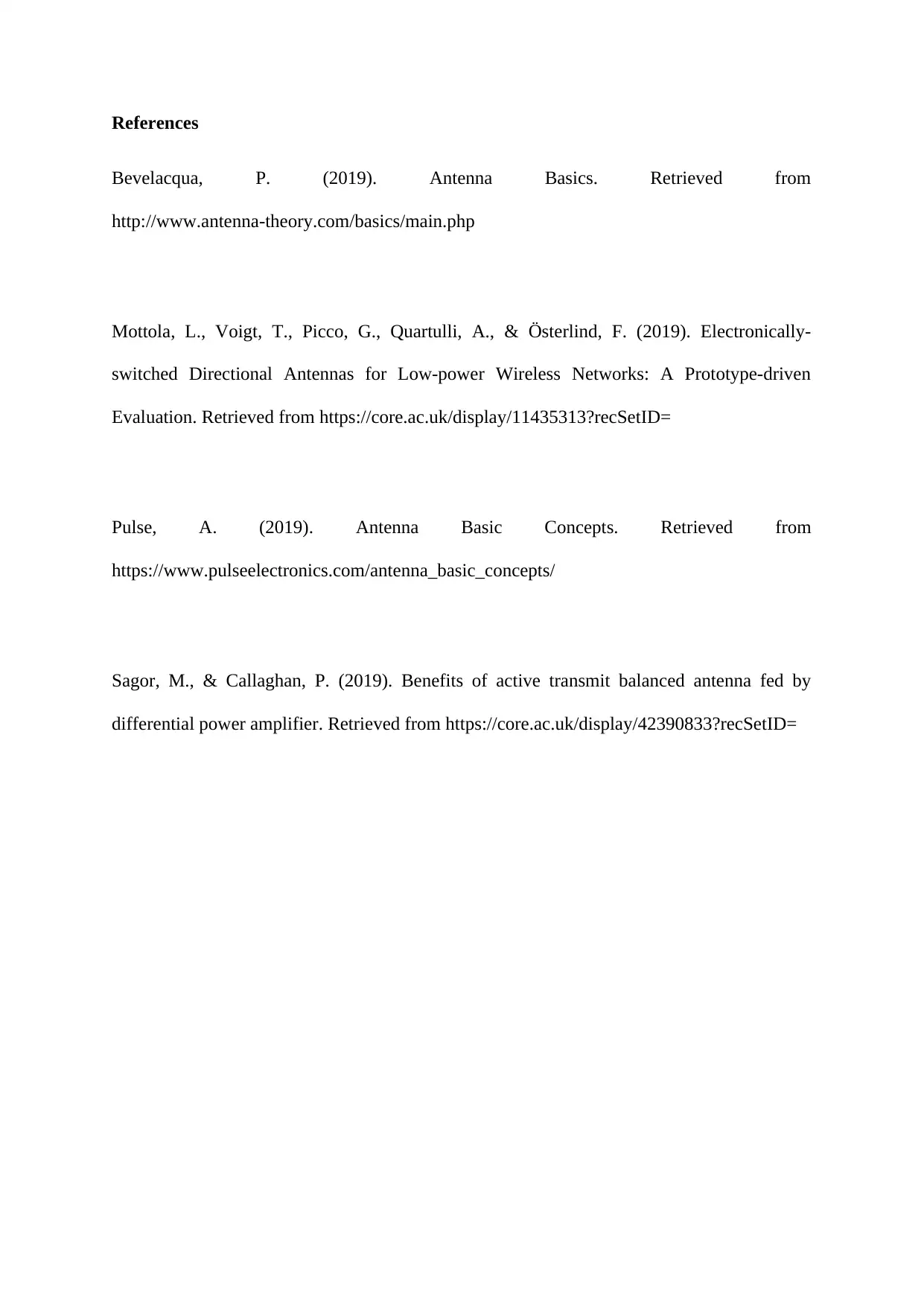
References
Bevelacqua, P. (2019). Antenna Basics. Retrieved from
http://www.antenna-theory.com/basics/main.php
Mottola, L., Voigt, T., Picco, G., Quartulli, A., & Österlind, F. (2019). Electronically-
switched Directional Antennas for Low-power Wireless Networks: A Prototype-driven
Evaluation. Retrieved from https://core.ac.uk/display/11435313?recSetID=
Pulse, A. (2019). Antenna Basic Concepts. Retrieved from
https://www.pulseelectronics.com/antenna_basic_concepts/
Sagor, M., & Callaghan, P. (2019). Benefits of active transmit balanced antenna fed by
differential power amplifier. Retrieved from https://core.ac.uk/display/42390833?recSetID=
Bevelacqua, P. (2019). Antenna Basics. Retrieved from
http://www.antenna-theory.com/basics/main.php
Mottola, L., Voigt, T., Picco, G., Quartulli, A., & Österlind, F. (2019). Electronically-
switched Directional Antennas for Low-power Wireless Networks: A Prototype-driven
Evaluation. Retrieved from https://core.ac.uk/display/11435313?recSetID=
Pulse, A. (2019). Antenna Basic Concepts. Retrieved from
https://www.pulseelectronics.com/antenna_basic_concepts/
Sagor, M., & Callaghan, P. (2019). Benefits of active transmit balanced antenna fed by
differential power amplifier. Retrieved from https://core.ac.uk/display/42390833?recSetID=
⊘ This is a preview!⊘
Do you want full access?
Subscribe today to unlock all pages.

Trusted by 1+ million students worldwide
1 out of 6
Related Documents
Your All-in-One AI-Powered Toolkit for Academic Success.
+13062052269
info@desklib.com
Available 24*7 on WhatsApp / Email
![[object Object]](/_next/static/media/star-bottom.7253800d.svg)
Unlock your academic potential
Copyright © 2020–2025 A2Z Services. All Rights Reserved. Developed and managed by ZUCOL.




